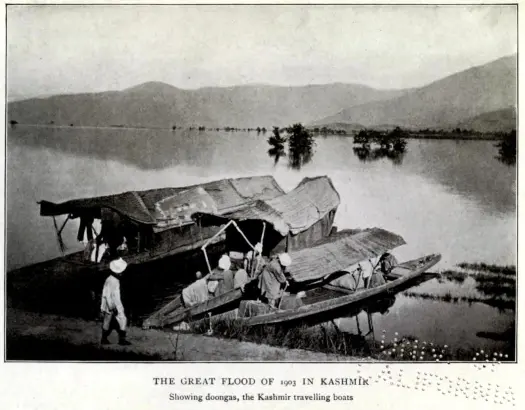
On July 23, 1903, the greatest recorded flood ever hit Kashmir. By 10 o’clock, the bund protecting the Dal Lake was breached, causing the water to rise 10 feet above its high level and causing significant damage to floating gardens, houses, and other structures.
Kashmir has a history of devastating floods, with the most recent occurring in 2014. Numerous large-scale floods have been recorded in the 19th and 20th centuries. A major disaster struck the valley in 1893 following heavy rainfall. According to Saligram Bhatt in his 2004 book, Kashmir Ecology and Environment: New Concerns and Strategies, the water level during the 1903 floods was three points higher than the 1893 floods.
Bhatt noted, “7,000 dwellings went down in the neighbourhood of the city, including 773 on the Dal Lake.”
The 1903 flood devastated Srinagar, however, historical poems from the flood indicate that the floods had started in south Kashmir, as it specifically mentions the river Wishaw, a Jhelum tributary through Kulgam. The ditty goes as:
buji aki dop yi kya dedi goum
kasabay osum su kout dedi gom
su ha dedi nyunay gura aban
zor kor veshive sahlabanTranslation:
O granny dear, what shall I say,
My headscarf has been carried away.
The river roared, the flood ran wild,
Veshav burst forth, fierce and untamed.
Though the floods were heart-wrenching like any human tragedy, the heart fills with joy when reflecting on the unity and compassion demonstrated by Kashmiri Pandits living across British India during the early 20th century.
The Kashmiri Pandit community living outside Kashmir that time, organized a large-scale relief effort. They launched a campaign to seek and collect donations from their community members and extended networks across India. This pan-India mobilization highlighted the indomitable spirit and unbreakable bond that the Kashmiri Pandits maintained with their homeland. Despite their geographical separation, their connection to Kashmir remained profoundly strong.
A document (1905) highlighting the efforts of Kashmiri Pandits living outside India to provide relief to their brethren back home.
The fostering of unity within the community for their devastated Kashmiri brethren projected an empathy and cohesiveness rarely seen. Their motive was clear: to assert their sense of belonging to Kashmir and provide relief to all Kashmiris, irrespective of caste, community, or religion. This spirit of solidarity and humanitarianism extended beyond immediate relief. It also fostered a sense of cultural and emotional continuity with their ancestral land, reinforcing their identity and heritage.
A similar situation repeated itself years later when Kashmiri Pandits living abroad rose to the occasion, trying to mobilize resources to support the educational and medical needs of some of their community members who were victims of forced migration from Kashmir. This demonstrated a continuity of the values of compassion, unity, and resilience that the community upheld.
Historical records reveal that it was the quality leadership and efforts of the then Governor of Kashmir, Pandit Manmohan Nath Koul and the renowned Kashmiri Advocate from Allahabad, Pandit Tej Bahadur Sapru, who played a crucial role in galvanizing the Kashmiri Pandit community for this noble cause.
Their leadership ensured that the relief efforts were well-coordinated and effective. A special Kashmir Relief Fund account was created in the Upper India Bank Limited, Allahabad of the then United Provinces where the collected money (which was more than ten thousand rupees) was deposited and subsequently disbursed through the office of the Governor of Kashmir.
Donations continued to pour in until May 1905, reflecting the sustained commitment of the community.
Rare documents from that period, analyzed by Kashmir Rechords, present formidable correspondence between, Sri Pratap Singh, the Maharaja Bahadur of Jammu and Kashmir, and Governor of Kashmir.
In one of the communications dated May 5, 1905, Maharaja Pratap Singh inquired about the remaining corpus of funds collected by Kashmiri Pandits within and outside Kashmir that had not yet been distributed. The Governor of Kashmir, Pandit Manmohan Koul responded by informing the Maharaja that he had a remaining amount of over 500 rupees, 6 annas, and 9 payas with him.
In a subsequent communication dated May 31, 1905, Maharaja Pratap Singh directed Governor of Kashmir to forward the undisbursed relief amount to the management committee of Hindu College, Srinagar.
The article was originally published on Kashmir Rechords.
